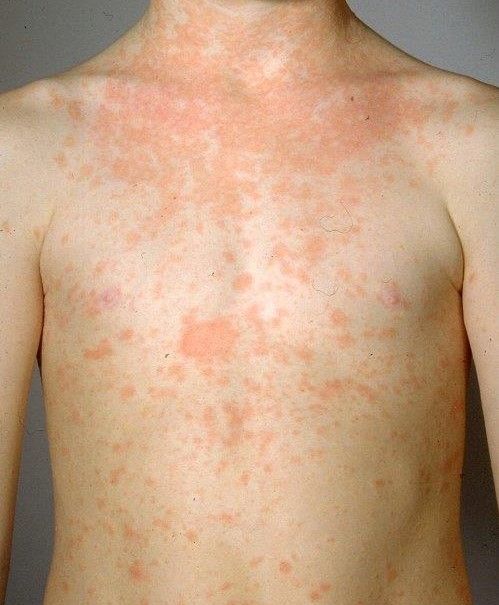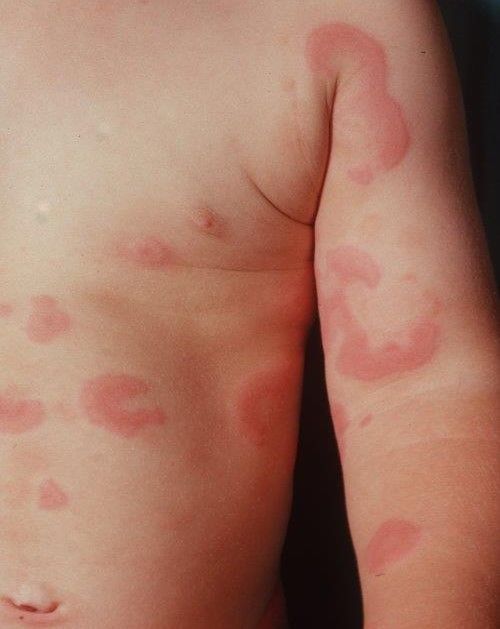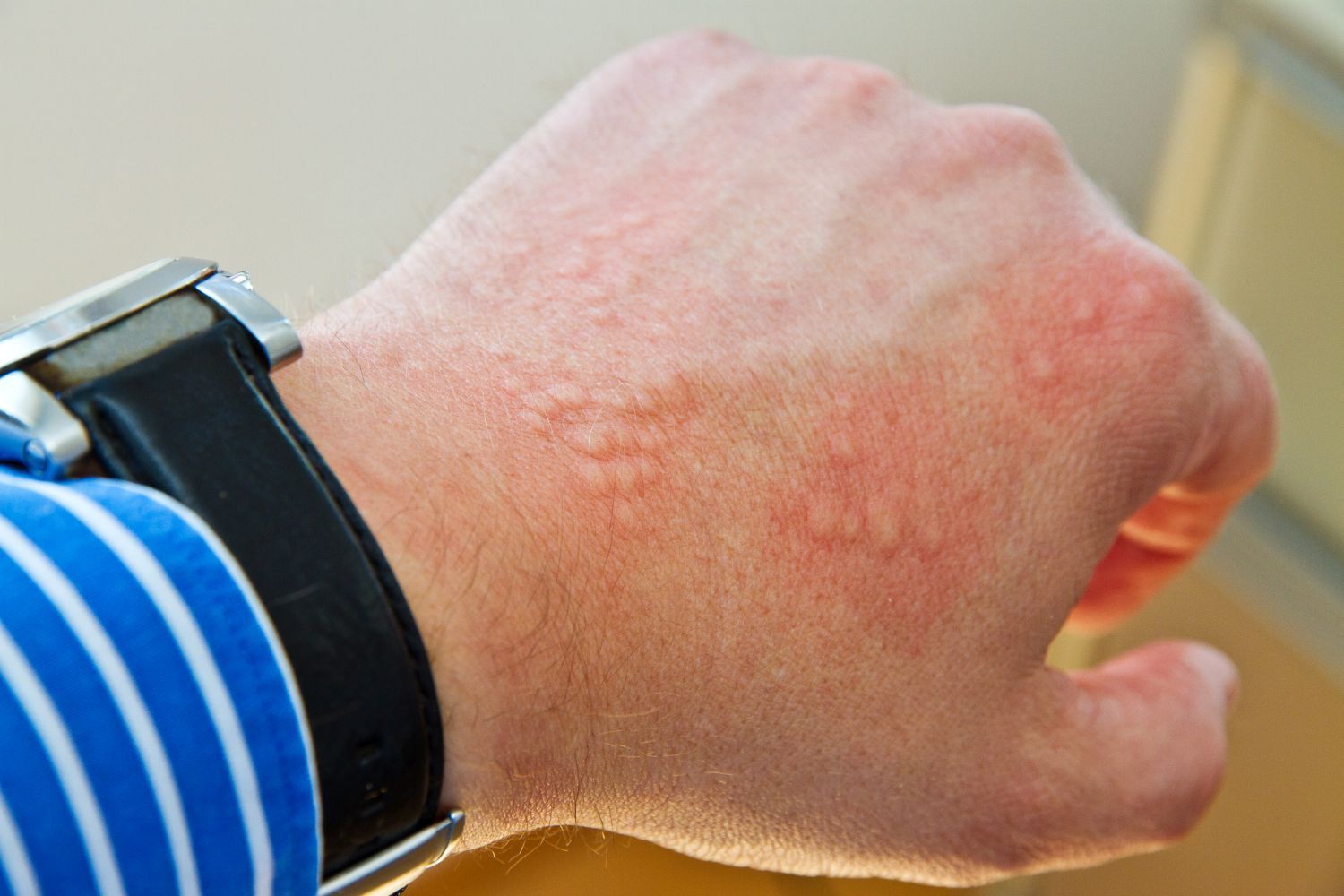Overview: What is hives
Hives is the generic term for certain skin conditions. Typically, you get a rash that appears in the form of itchy wheals. It may be localized or extend over larger areas or the entire body. Their skin changes are reminiscent of symptoms that appear after contact with a stinging nettle (Latin: urtica = nettle). In some cases, so-called angioedema, extensive swelling of the subcutaneous tissue and certain areas of the mucous membrane, also develops. It is estimated that about one in four people will temporarily develop hives once in their lifetime. The skin rash is not contagious and also not life-threatening, but it can considerably restrict your quality of life – on the one hand due to the visible skin changes and also due to the strong itching usually associated with it. This sometimes causes other people to keep their distance. All these factors can also affect your psyche.
A variety of factors can contribute to or cause hives. Therefore, the cause research is complex.
Acute and chronic hives
Generally, we distinguish between two courses of hives based on duration:
- Acute: If the disease lasts up to six weeks, we speak of acute hives.
- Chronisch: Die chronischeNesselsucht besteht länger als sechs Wochen. If the urticaria is chronic, we distinguish between different forms of progression:
- In chronic continuous urticaria , they experience daily flare-ups with wheals and itching.
- In chronic recurrent urticaria, episodes of disease alternate with symptom-free phases. Both the relapses and the symptom-free phases can last for weeks or months.
Hives: Causes, forms, triggers
Research into the causes of hives (urticaria) is very complex. In many cases, no specific trigger can be traced.
Even though the development of hives is very complex, all forms have one thing in common: certain immune cells (so-called mast cells) secrete pro-inflammatory messenger substances, including predominantly histamine. The messenger stimulates immune cells of your skin and cells responsible for sensory perception. Typically, they become active when attackers such as parasites or hostile bacteria besiege the body. Histamine gives the starting signal for a localized or a large-scale spreading inflammation of your skin. It swells, reddens, itches and forms wheals. For example, an allergic reaction, such as to pollen or food, can activate mast cells. However, there are many other factors that can stimulate mast cells. Thus, not all hives are allergic.
Forms and triggering factors of urticaria
Various factors can cause hives to break out and the typical rash to develop. The three main forms include:
- Spontaneous urticaria: Symptoms appear spontaneously, with no apparent external trigger.
- Physical urticaria: External stimuli such as cold, heat or pressure trigger the skin changes.
- Other forms of urticaria: Factors such as exertion, contact with water, or allergies provoke the hives.
1. Spontaneous urticaria
In spontaneous urticaria, wheals or angioedema form spontaneously, “out of the blue.”
We distinguish two forms here:
Spontaneous acute urticaria, the symptoms of which subside after six weeks at the latest. Triggers are, for example, infections, sometimes in combination with painkillers. Acute allergic reactions, for example to insect stings by bees or wasps, food or medications, can also occur with acute urticaria and then possibly also be associated with dangerous symptoms such as asthma or circulatory collapse; these complaints then manifest themselves quickly, practically always within the first hour after the allergic contact. If a current urticaria manifests itself for the first time and runs its course without accompanying symptoms, further clarification is not absolutely necessary.
Spontaneous chronic urticaria with symptoms lasting longer than six weeks. Possible triggers are:
- Medicines (such as acetylsalicylic acid)
- Intolerance to food additives, preservatives, colorants
- Autoimmune diseases, including, for example, rheumatism
- Chronic infections, such as of the paranasal sinuses or pharyngeal tonsils

2. Physical urticaria
Pressure and temperature stimuli trigger physical urticaria. Their symptoms are usually confined to the area where the stimulus occurred. However, sometimes it spreads over a larger area.
There are several triggers of physical hives. These include:
Mechanical stimuli: urticaria factitia, pressure urticaria, vibration urticaria
When mechanical stimuli act on your skin, hives may also break out.
The most common form is urticaria factitia, or skin pruritus. The rash is caused by shear forces, such as when fabric scratches, rubs or rubs. Then, within minutes, the typical wheals form and the skin itches. The rash persists between two and eight hours. In the case of the special form Urticaria factitia tarda, the characteristic rash appears with a delay of at least 30 minutes to a maximum of four hours after the irritation. Pressure urticaria, which is a result of clothing that is too tight, for example because you have buckled your belt too tightly, also occurs with a time delay of four to eight hours. If hives develop as a result of vibration, for example when you work with a percussion drill, it is vibratory urticaria.
Why the mast cells in your skin increasingly release the messenger substance histamine has not yet been conclusively clarified. The mechanical stimulus is the trigger, but the actual causes usually remain obscure. Suspected are about
- a drug intolerance to acetylsalicylic acid, codeine, lidocaine or penicillin,
- an infestation with parasites,
- mastocytosis, due to which there are too many mast cells in the skin and organs
- or also intolerances to certain foods.
Temperature stimuli: cold urticaria, heat urticaria, light urticaria
Cold urticaria occurs when you have contact with cold water, ice, or cold metals. Symptoms may be localized or over a large area.
This form of hives resulting from exposure to cold, such as after jumping into ice-cold water, can be life-threatening. This is because anaphylaxis (anaphylactic shock) can occur, i.e. an excessive reaction of the immune system. This complication is very rare.
In most cases, cold urticaria has no underlying other disease. In individual cases, for example, infections or chronic inflammations are identified as triggers; however, this is rather the exception.
Heat urticaria, in turn, is the result of exposure to heat. Both natural daylight and UVA radiation, for example in a solarium or from a halogen lamp, can trigger light urticaria.
Symptoms: Hives appears with typical rash
You can recognize hives by the following typical symptoms:
- Urticaria begins with severe itching of the skin, rarely it also burns. Usually, you are more likely to feel the need to rub or squeeze the affected skin area. With other itchy skin conditions, such as eczema, sufferers are more likely to want to scratch.
- Then you get a skin rash in the form of small wheals, reminiscent of the skin change after contact with a nettle. The rash is clearly distinguishable from unaffected areas of the skin. It may appear limited, but may also extend over larger areas. The wheals often regress after minutes, or a few hours, usually after 24 hours at the most. However, they often form again afterwards and reappear at new locations at best.
- Sometimes the so-called angioedema occurs in the context of acute hives. This is a cushion-like, elastic swelling of the tissues under the skin or mucous membranes because aqueous fluid accumulates there. Angioedema often forms on the face, hands, feet, and genitals. In the area of the mucous membranes, the larynx or tongue may swell. It can become life-threatening if swelling obstructs breathing. Sometimes pain or itching accompanies the swelling, which usually lasts up to 72 hours. Angioedema indicates a hypersensitivity reaction of the body.
- In rare cases, angioedema also occurs without accompanying urticaria; in these cases, hypersensitivity to certain drugs (especially blood pressure drugs, so-called ACE inhibitors) or rare inherited disorders of the coagulation system(hereditary angioedema, HAE) must also be considered.

Hives: Emergency anaphylactic shock
If you suffer from an allergy and suddenly develop symptoms of hives, in rare cases this can lead to anaphylaxis. If you are allergic to bee venom, for example, you may experience symptoms of urticaria after a sting, with itching, wheals and swelling, and even allergic shock.
The following symptoms characterize anaphylaxis:
- Your blood pressure drops, you experience circulatory weakness and even unconsciousness.
- You feel unwell, vomit, get diarrhea.
- You get anxious.
- Your bronchial muscles tense up, which is why you experience shortness of breath.
- Your heart races.
If left untreated, the combination of symptoms can lead to cardiovascular and respiratory arrest.
Diagnosis hives
Because of the typical rash, the diagnosis of hives is usually not difficult for us. It is more complex to track down the actual cause of urticaria.
First, we will ask about the patient’s medical history (anamnesis). For example, we will ask you:
- How long have you been suffering from hives?
- How long and how often has the rash occurred so far?
- Did he change during the day?
- Have you ever been treated for urticaria before?
- Has tissue swelling (angioedema) occurred, for example, on the face, hands, feet, or genital area?
- Is there an intolerance to certain foods or medications?
- Could certain physical stimuli have triggered the rash, e.g. cold, heat or pressure?
As a rule, we do not examine acute urticaria more closely, since it soon disappears. However, if you suffer from chronic hives, it is important to find their triggers.
Hives (Urticaria): Prevention, Early Detection, Prognosis
You can not prevent the skin disease. However, if you have suffered from it before, you can prevent another outbreak by avoiding the trigger. Since the symptoms usually occur abruptly, early detection is not possible.
The symptoms of acute hives usually last only a few days, at most a few weeks. If you are lucky, they will never occur again.
Chronic hives persist for years, sometimes decades, in rare cases. Then the usual symptoms occur daily, weekly or less frequently. For the prognosis of the chronic form, it is important to systematically research the possible causes and triggers in order to avoid them or find a therapy.
Some examples:
- If medications you are using trigger the hives, you should discontinue them if possible after consulting with us and switch to another active ingredient.
- Often infections promote chronic hives. These include, for example, inflammation of the gastric mucosa caused by the bacterium Helicobacter pylori or bacterial infections of the nose and throat. Treating these infections then helps with the hives.
- If a food or material, such as latex, triggers the hives, you should avoid these substances.
Hives: Treat the urticaria
Acute hives usually subside within a short time without therapy. If necessary, medications such as antihistamines can effectively alleviate your symptoms.
If you suffer from long-lasting, chronic urticaria, you should work with us to identify the triggers and causes in order to eliminate them. The search for the cause and therapy, even with medication, can be difficult and require a lot of patience.


